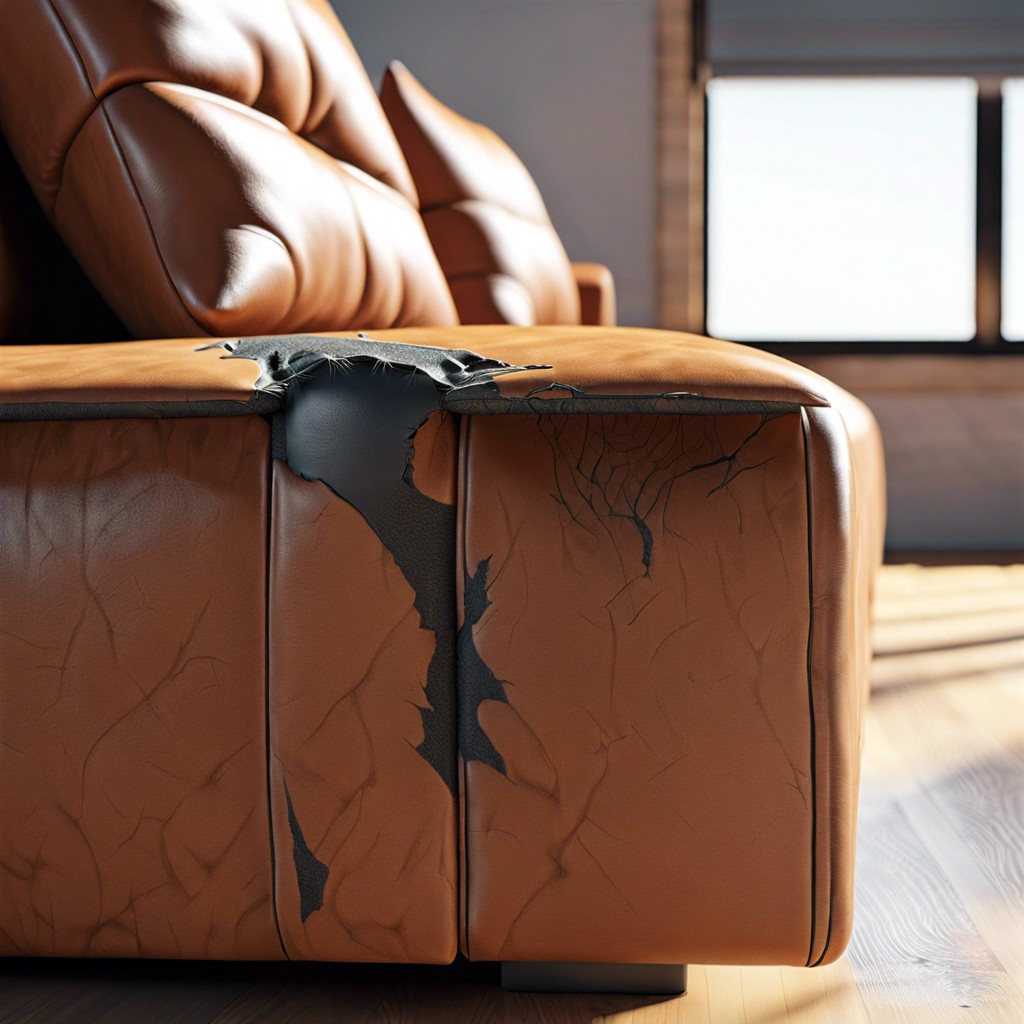Last updated on
Discover effective methods to repair cat scratches on your couch, restoring its appearance and extending its lifespan.
Key takeaways:
- Assess the extent of scratching before repairing.
- Trim and snip loose fibers before applying fillers or patching.
- Use a filler for leather scratches and a felting needle for fabric couches.
- Attach a fabric patch to large tears or holes.
- Implement protective measures to prevent future scratches: deterrent sprays, plastic protectors, alternative scratching options, trimming claws, and using nail caps.
Table of Contents
Assess the Extent of Scratching

Begin by closely examining the couch to determine the severity of the scratches. Light scratches may only affect the surface, while deeper ones can penetrate into the leather or fabric. For leather couches, check if the color has been removed or if it’s just the coating that is affected. On fabric sofas, look for any threads that may have been pulled out or if the structure of the material itself has been compromised.
Identify whether the scratches are isolated to one area or if they are spread across a larger surface. This will help in planning the repair approach and in understanding how much material or product you will need. Take note of the direction of the scratches as this can influence the method you’ll use to camouflage or repair the damage.
It is also important to determine the type of material your couch is made of. Each material, whether it be leather, microfiber, or another fabric type, will require a different repair strategy and set of products. Knowing the material composition will guide you in choosing the appropriate repair method, ensuring that you do not cause further damage in the attempt to fix it.
Trim and Snip Loose Fibers
Careful trimming of loose fibers is key to a smooth repair job. Use sharp scissors for precision cutting, ensuring you don’t remove more material than necessary. Focus on high fidelity to the couch’s original texture and appearance. After snipping, lightly sand the area if dealing with leather to create an even surface. For fabric couches, avoid sanding as it may cause further fraying. This preparation sets the stage for the subsequent application of fillers or patching, forming the foundation for a seamless restoration.
Apply Filler to Leather Scratches or Use Felting Needle for Fabric Couches
For minor scratches on leather, a filler can work wonders to make your couch look as good as new. Choose a leather filler that closely matches your couch’s color. Apply it carefully into the scratches with a palette knife or a small spatula, smoothing it over to ensure it’s level with the leather surface. Allow the filler to dry completely as per the manufacturer’s directions usually, then gently buff the area with a soft cloth.
If your couch is covered in fabric and bears the marks of cat play, a felting needle can be particularly effective. This tool consolidates fibers, reducing the appearance of scratches. Start by using the felting needle to push down any frayed edges around the scratch site. Then, repeatedly stab the needle into the affected area to intertwine the fibers, which can help mask the damage. Work patiently, as this is a delicate process that gradually improves the look of the fabric.
Attach a Fabric Patch to Large Damages
If you’re facing large tears or holes as a result of your feline’s fervent clawing, a fabric patch is an effective solution. Choose a piece of fabric that closely matches your couch’s texture and color for a seamless repair. Here’s how to proceed:
First, cut the patch ensuring it covers the damaged area completely, allowing for an extra inch around the tear for a secure fit. Use a curved upholstery needle for the job, as it easily maneuvers through the couch’s fabric and makes the job simpler.
Apply a thin layer of fabric glue to the edges of the patch, then carefully position it over the tear. If you’re dealing with a very thin or delicate fabric, consider placing a lightweight mesh fabric between the patch and the couch material for added support.
Stitch the patch to the couch using a color-coordinated thread. Try to keep your stitches small and even for a tidy look. If you’re not confident with your sewing skills, fabric glue can serve as a temporary fix until a professional can assist you.
Once affixed, allow ample time for the glue to dry completely before using the couch. In the meantime, consider how to deter your cat from future scratching, such as providing alternate scratching surfaces or deterrent sprays. This proactive approach not only keeps your repair intact but also preserves the overall integrity of your furniture.
Implement Protective Measures to Prevent Future Scratches
After repairing the couch, it’s important to take steps to prevent your cat from scratching the furniture again. Here are effective ways to safeguard your couch:
Use a scratch deterrent spray on the couch, which releases a scent that cats dislike but is usually pleasant to humans. Regular application can discourage your cat from approaching the furniture to scratch.
Install clear plastic protectors on the corners and sides of the couch. These are the spots cats often favor for scratching. The protectors are nearly invisible and provide a barrier against claws.
Provide alternative scratching options such as scratching posts or pads placed near the couch. Encourage your cat to use these by sprinkling catnip on them or dangling a toy for your cat to play with.
Keep your cat’s claws trimmed. Shorter claws do less damage and can make a significant difference in protecting your furniture.
Consider using soft nail caps for cats. These caps are glued onto your cat’s nails and prevent them from causing harm when scratching.
By implementing these strategies, you maintain a scratch-free couch and a happy environment for both you and your cat.




